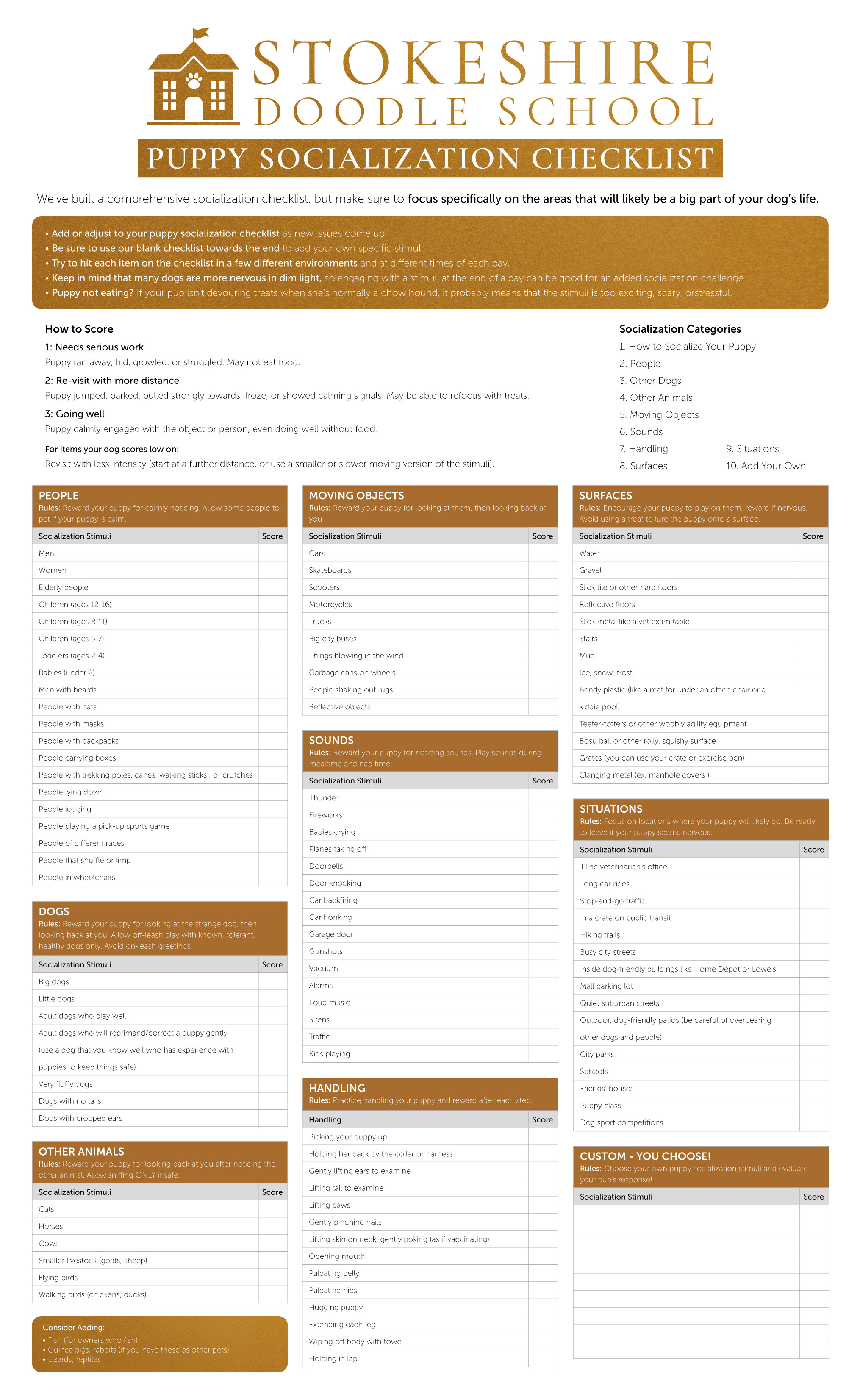HOW DO I SOCIALIZE MY DOODLE PUPPY?
Socialization means learning to be part of society. When we talk about socializing pet puppies, it means helping them learn to be comfortable as a pet within human society-a society that includes many different types of people, environments, buildings, sights, noises, smells, animals and other dogs.
Most young animals, including dogs, are naturally made to be able to get used to the everyday things they encounter in their environment-until they reach a certain age. When they reach that age, they are naturally made to become much more suspicious of things they haven’t yet experienced. God made them with an incredible genome to adapt to their environment through gene expression, epigenetics and natural selection over time. This age-specific natural development lets a young puppy get comfortable with the everyday sights, sounds, people and animals that will be a part of his life. It ensures that he doesn’t spend his life jumping in fright at every blowing leaf or bird song. The later suspicion they develop in later puppyhood also ensures that he does react with a healthy dose of caution to new things that could truly be dangerous.
What Age Is Best for Puppy Socialization?
Puppies are most accepting of new experiences between 3 and 12 weeks old. After that age, they become much more cautious of anything they haven’t yet encountered. From about 12 to 18 weeks old the opportunity to easily socialize the puppy ends-and with each passing week it becomes harder to get the pup to accept and enjoy something that he’s initially wary of. After 18 weeks old, it’s extremely difficult, and sometimes impossible, to teach a dog to like something new, or help him become comfortable with something he or she finds frightening.
Why Is Puppy Socialization Important?
Well-socialized puppies usually develop into safer, more relaxed and enjoyable pet dogs. This is because they’re more comfortable in a wider variety of situations than poorly socialized dogs, so they’re less likely to behave fearfully or aggressively when faced with something new. Poorly socialized dogs are much more likely to react with fear or aggression to unfamiliar people, dogs and experiences. Dogs who are relaxed about honking horns, cats, cyclists, veterinary examinations, crowds and long stairwells are easier and safer to live with than dogs who find these situations threatening. Well-socialized dogs also live much more relaxed, peaceful and happy lives than dogs who are constantly stressed out by their environment.
Socialization isn’t an “all or nothing” project. You can socialize a puppy a bit, a lot, or a whole lot. The wider the range of experiences you expose your doodle puppy to, the better chances he or she are of being comfortable in a wide variety of situations as an adult.
HOW DO I SOCIALIZE MY DOODLE PUPPY?
We recommend taking your puppy with you everywhere! The more places, sights, sounds, and smells the better. The rule of thumb with puppy socialization is to keep a close eye on your puppy’s reaction to whatever you expose him or her to so that you can tone things down if your pup seems at all frightened. Always follow up a socialization experience with praise, petting, a fun game or a special treat. You want to associate new experiences with positive reinforcement. If you have begun crate training, we recommend allowing your puppy to go to their ‘safe space’ and trying again in the future. Whenever negative experiences happen, it’s important to introduce your puppy to the scary situation much more gradually, and to make a big effort to do something your puppy loves during the situation or right afterwards.
Other Safe Ways to Safely Socialize a doodle Puppy Who Is Not Fully Vaccinated
Drive to a busy shopping area and hang out with your pup on a mat at the entrance. Strangers will flock to you because they want to pet your puppy and they’ll willingly feed him the treats that you’ve brought with you.
Host a puppy party! Invite friends and family over, play some music, toss some streamers, and pass your pup around.
Bring your puppy to a park. Supervise the children interacting with him or her to make sure he’s not frightened by them and they’re being gentle.
Take your doodle pup on car rides through different neighborhoods, drive-thrus, car washes, and out into the country where he’ll see and smell a variety of farm animals.
Arrange play sessions with other puppies and adult dogs who you know are healthy and friendly.
If your puppy is small enough, carry him around town and let strangers pet him and give him treats.
Should I be concerned about my puppy or I contracting a disease while socializing?
The risk of infection is quite small compared to the much larger risk of your puppy developing serious behavior problems with fear and aggression later in life. Keep your puppy up to date on their vaccinations and take proper precautions. The great news for you, is that dogs help you build your immune system! Dogs work like a probiotic, helping you to develop healthy bacteria colonies that in turn boost your immune system – stopping you from getting ill and, potentially, keeping you having allergies. source
The Puppy’s Rule of Twelve
Make sure all experiences are safe and positive for the puppy. Each encounter should include treats and lots of praise. Slow down and add distance if your puppy is scared! By the time a puppy is 12 weeks old, it should have: (If your puppy is over 12 weeks start right away with this socialization guide.)
Experienced 12 different surfaces: wood, woodchips, carpet, tile, cement, linoleum, grass, wet grass, dirt, mud, puddles, deep pea gravel, grates, uneven surfaces, on a table, on a chair, etc.
Played with 12 different objects: fuzzy toys, big & small balls, hard toys, funny sounding toys, wooden items, paper or cardboard items, milk jugs, metal items, car keys, etc.
Experienced 12 different locations: front yard (daily), other people’s homes, school yard, lake, pond, river, boat, basement, elevator, car, moving car, garage, laundry room, kennel, veterinarian hospital (just to say hi & visit, lots of cookies, no vaccinations), grooming salon (just to say hi), etc.
Met and played with 12 new people (outside of family): include children, adults (mostly men), elderly adults, people in wheelchairs, walkers, people with canes, crutches, hats, sunglasses, etc.
Exposed to 12 different noises (ALWAYS keep positive and watch puppy’s comfort level – we don’t want the puppy scared): garage door opening, doorbell, children playing, babies screaming, big trucks, Harley motorcycles, skateboards, washing machine, shopping carts rolling, power boat, clapping, loud singing, pan dropping, horses neighing, vacuums, lawnmowers, birthday party, etc.
Exposed to 12 fast moving objects (don’t allow to chase): skateboards, roller-skates, bicycles, motorcycles, cars, people running, cats running, scooters, vacuums, children running, children playing soccer, squirrels, cats, horses running, cows running, etc.
Experienced 12 different challenges: climb on, in, off and around a box, go through a cardboard tunnel, climb up and down steps, climb over obstacles, play hide & seek, go in and out a doorway with a step up or down, exposed to an electric sliding door, umbrella, balloons, walk on a wobbly table (plank of wood with a small rock underneath), jump over a broom, climb over a log, bathtub (and bath) etc.
Handled by owner (& family) 12 times a week: hold under arm (like a football), hold to chest, hold on floor near owner, hold in-between owner’s legs, hold head, look in ears, mouth, in-between toes, hold and take temperature (ask veterinarian), hold like a baby, trim toe nails, hold in lap, etc.
Eaten from 12 different shaped containers: wobbly bowl, metal, cardboard box, paper, coffee cup, china, pie plate, plastic, frying pan, Kong, Treatball, Bustercube, spoon fed, paper bag, etc.
Eaten in 12 different locations: back yard, front yard, crate, kitchen, basement, laundry room, bathroom, friend’s house, car, school yard, bathtub, up high (on work bench), under umbrella, etc.
Played with 12 different puppies (or safe adult dogs) as much as possible. Left alone safely, away from family & other animals (5-45 minutes) 12 times a week.
Experienced a leash and collar 12 different times in 12 different locations.
Positive Paws Dog Training ©2002 - Margaret Hughes Adapted with permission from Pat Schaap's "RULE OF 7's" for 7 week old puppies



